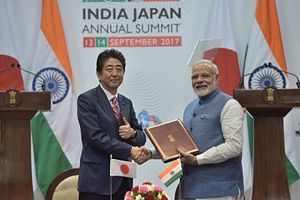The Japanese government’s lending arm, the Japan International Cooperation Agency (JICA), has provided assistance for a number of important infrastructure projects in South Asia, including the New Delhi metro (JICA funded 60 percent of the first phase of the project). It is also now providing assistance for the Mumbai-Ahmedabad bullet train project, as well as the Western Dedicated Freight Corridor, as well as some important infrastructural projects of strategic importance in northeastern India, including NH 54 (the aim is to improve a 380 kilometer stretch in Mizoram) and NH 51 (40 kilometers of this stretch within Meghalaya will be upgraded). For the first time, Japan has been allowed to participate in projects in India’s northeast.
In recent years, Japan has begun to focus not just on its economic presence in South Asia, but also on achieving its strategic goals. This is evident through JICA’s participation in crucial port projects in the Indian Ocean. It has been providing assistance for the geopolitically relevant Matarbori deep sea port, which will reduce pressure on Chittagong port and see a coal terminal built by 2022. In Sri Lanka, Japan is providing financial assistance for port facilities at Trincomalee and Colombo.
The main reason for Japan’s presence is a desire in these South Asian countries, especially Sri Lanka, to look at alternatives beyond China for financing. South Asian leaders are wary of what has been dubbed as China’s “debt trap diplomacy.” In a media interview in March 2018, Sri Lankan Prime Minister, Ranil Wickremesinghe subtly made the point that Sri Lanka has options: “Just as much as there is the Belt and Road Initiative, the Japanese are also taking a big initiative — and the Indians.”
Likewise, during Sri Lankan President Maithripala Sirisena’s Japan visit in March 2018, he discussed maritime cooperation specifically in the context of the Indo-Pacific with Japanese Prime Minister Shinzo Abe. Abe declared, “Our two countries will work hand in hand to make the Indo-Pacific a global commons to provide peace and prosperity for countries indiscriminately.”
What is also significant is that India and Japan, which share a robust bilateral relationship, are now looking to work together on important infrastructure projects in South Asia. Both Tokyo and New Delhi realize that they cannot singlehandedly compete with the Chinese presence in South Asia. As a result they have decided to work closely together under the Partnership for Quality Infrastructure (PQI). New Delhi and Tokyo are also working together for the development of the Asia-Africa Growth Corridor (AAGC), which is a component of the Indo-Pacific freedom corridor.
Significantly, there are a number of other projects in Bangladesh and Sri Lanka where it is not just the governments, but Indian and Japanese enterprises working together.
Japanese company Marubeni and India’s Larsen & Toubro Ltd. will supply electrical and mechanical railway systems for Dhaka MRT Line 6 (which is being funded by JICA) to the tune of 55 billion Japanese yen ($500 million). Construction will begin in July 2018, and the target date of completion is July 2022. Both these companies have also joined forces to build two power plants in Bangladesh. In Sri Lanka, Petronet LPG and its Japanese partner have agreed to set up a LNG terminal, with a total investment of $300 million.
While the narrative of India-Japan cooperation in South Asia has a long way to go in order to become a challenger to China’s Belt and Road, cooperation between Indian and Japanese enterprises should be welcomed, as it provides another alternative to China. More and more countries in South Asia are not happy with China’s growing clout – there is an undercurrent of resentment visible. While China has a massive advantage in terms of resources, countries like India and Japan provide favorable terms of financial assistance, and the help they provide is more sustainable in the long run.
The next aim should be to deepen Japan-India cooperation in Southeast Asia, starting in Myanmar. While Japan already has a strong economic presence and is participating in important infrastructure projects in the region, India is yet to emerge as a serious player. Both countries should look at possible synergies in the infrastructure sector. Importantly, this need not be purely strategic in nature; cooperation between business enterprises of both countries should also be encouraged.
Merely being alarmist about China’s economic presence in South Asia is not sufficient. It is time to come up with a feasible alternative and not restrict this approach to a handful of projects.
Tridivesh Singh Maini is a New Delhi-based Policy Analyst associated with The Jindal School of International Affairs, OP Jindal Global University, Sonipat. The views expressed here are personal

































